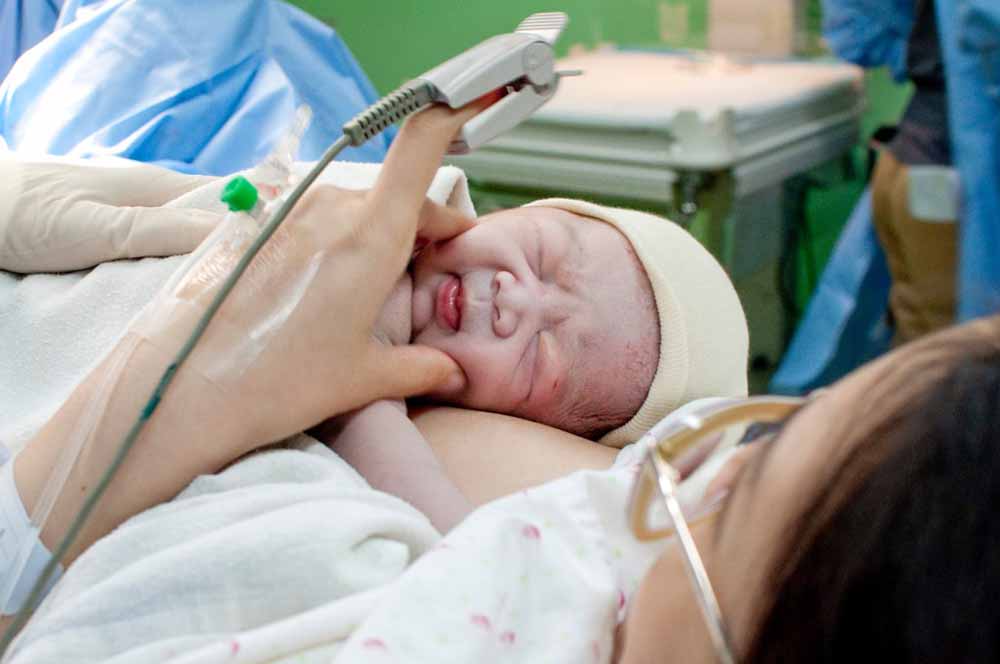10 Things Your Friends Haven’t Told You About Childbirth

If this is your first pregnancy rodeo, you’ve probably already discovered a few of the undisclosed aspects of growing a baby. After all, few people voluntarily strike up a conversation about the stray hairs cropping up on their chins or their leaky boobs prematurely protected with nursing pads. Once you can personally relay an anecdote about a potent gas-passing-on-an-elevator incident, your peers willingly pipe up with similar stories. Prior to your shared experience, though, all they let you in on is adorable bumps and unusual cravings. It’s as if you can’t know the secrets of the moms-to-be club until you’re a card-carrying member.
With nearly nine months under your belt, you’ve finally become schooled in many of the unexpected elements of expecting—but there are still a handful of taboo topics left to encounter (and left out of your gal pals’ birth stories). We’re here to clue you in on what really happens behind closed delivery room doors. Be warned, though, it isn’t all ice chips and painkillers.
Shave It For Later
Our first insider tip? Nobody cares about the state of your pubic hair. In the weeks leading up to the big day, you may wonder if “get a wax” deserves a line on your to-do list, but Jeanne Faulkner, RN, author of Common Sense Pregnancy: Navigating a Healthy Pregnancy and Birth for Mother and Baby and creator of the Common Sense Pregnancy & Parenting podcast, assures, “The only person in your delivery room who will give a hoot about if you shave is you.”
Tracie Achrem, MSN, CNM, who specializes in well-woman care at Women First OB/GYN and attends births at William Beaumont Hospital and the Karmanos Center for Natural Birth in Royal Oak, Michigan, agrees: “Au naturel, trimmed, waxed or completely bald—there are not grooming etiquette standards for pregnancy. Do what you feel comfortable addressing.”
“Same goes for your legs,” adds Faulkner. “We see women from all cultures, countries and walks of life. Some shave; some don’t—and it makes no difference to us.” So, if you’re in the throes of labor, feel free to bypass the razor (as if you could reach your ankles or nether regions anyway) and head straight for the hospital.
Lose Your Lunch
Did you think you were finished throwing up once you made it out of the first trimester? Think again. Nausea and vomiting are a common part of the labor experience. “Rapidly changing hormones, contractions squeezing your abdomen and going without food during labor make plenty of women queasy,” says Faulkner. A drop in blood pressure following an epidural can be a culprit, too.
If you suspect you might spew, give your nurse a heads-up, so she can have
a bag or basin at the ready. “Most moms feel much better after they vomit, and most don’t suffer much nausea after that,” assures Faulkner. For those who do, medication may be available to help.
Shake It Off
If you start trembling during labor, don’t worry that it’s because you’re nervous. “‘The shakes’ are extremely common for women while transitioning in labor, as well as during the first hour of recovery,” says Achrem. “It isn’t known exactly why they occur or what causes them, but it’s thought they may be related to hormonal shifts that occur just before and following birth.”
While there’s nothing you can do to prevent the teeth-chattering or full-body-convulsing, covering up from head to toe with warm blankets can offer relief until it passes.
Wide-Open Spaces
Let out a sigh of relief: Episiotomies—that is, incisions made between the vaginal opening and the anus—are no longer a standard procedure. “Doctors used to think that if they cut an episiotomy, they’d make more room in the vagina, so the mother would not tear [during childbirth],” explains Faulkner. “As it turned out, more women tore more often when they had episiotomies than when they didn’t.”
In rare cases, an episiotomy may be required to make extra space, but in most instances, giving mom time to stretch, providing adequate perineal support and using techniques like massage, hot compresses and oil can help ensure she won’t need one, says Faulkner.
Worried about tearing? “Don’t be,” coaxes Achrem. “Not all women tear while giving birth.” If you do, the reasons could be numerous and are often unavoidable. But, she consoles, “The euphoria of meeting your baby and the endorphins released at that moment will help numb the pain.”
Final Bowel
Here’s the cold, hard truth: Most women poop while pushing. In fact, it’s hard not to! Because of the way baby’s head moves down into the rectal area during his exit, there’s nothing you can do to control it—and frankly, it’s better not to try.
“Please do not fear the poop,” pleads Achrem. “The more pooping is feared, the less effective one’s pushing tends to be.”
If it happens, rest assured no one will think twice about it. “It’s part of our job to make sure you stay as clean and tidy as possible and to protect your modesty and dignity,” says Faulkner. “We’ll do our best to clean things up so quickly that you might not even realize it happened.”
One More Time
A baby isn’t the only thing you’ll be delivering on birth day—the placenta also has to pass through your birth canal. After your new family member makes his debut, “you might feel a contraction or two as the placenta separates from the uterine wall and some strong cramps after it is delivered,” says Faulkner.
The soft, squishy, bone-free organ should slide out rather easily, though, and, compared to your 7-pound bundle of joy, will likely feel like a walk in the park.
Look Out Below
What kind of scene should you expect down under following delivery? Swelling and bruising are common. “If you have a tear, your midwife or doctor will suture you up, and those stitches will be visible until they dissolve on their own,” explains Faulkner. “In rare cases, your cervix might be so low in the vagina you can see it.”
But with time, things will heal. “Within a week or two, you’ll likely look very much like you did before birth,” Faulkner says. And within six weeks, you’ll be almost fully recovered. “While you still might feel sore or tender, you’ll also feel relieved that everything is pretty much back to normal.”
Contraction Action
In case you never got around to getting a prenatal massage, you can look forward to receiving one postpartum—or at least your former bump can. “To encourage the uterus to contract, your medical team will probably massage the ‘bump,’ or uterine fundus, firmly,” says Faulkner.
The contracting of the uterus helps the vessels that delivered blood to the placenta clamp down, which in turn helps decrease bleeding. In some cases, Pitocin may be administered to facilitate the process.
Go with the Flow
Lochia, or the shedding of the lining of your uterus following pregnancy, will consist of blood, tissue and mucus and be heavy for the first few days. “After that, your flow will get lighter and lighter,” says Faulkner, “but you can expect to have some light bleeding or spotting for as long as four to six weeks after birth.”
You’ll want to wear hospital-issued, industrial-strength pads in the beginning (some moms even swear by adult diapers), and then panty liners as your output tapers. Tampons are off-limits for at least six weeks after delivery to minimize risk of vaginal infection.
Poo Bear
In case talking about poop once wasn’t enough, we’re bringing it up again. From constipation to runs, the first No. 2 postpartum can cause concerns of all shapes and sizes. You may have a bowel movement right away, or it may be a couple days before anything passes through.
“Drink lots of water. Eat a high fiber diet and lots of fruits and veggies. Then, for good measure, consider taking an over-the-counter stool softener until you’re sure everything’s working as it should,” Faulkner advises. “Avoiding constipation is very important, so that first bowel movement isn’t too uncomfortable.”
As long as we’re talking toilets, know you’ll be bringing a new friend along to the ladies room. “A ‘peri-bottle’ can be filled with warm or cold water—whichever feels better—and can be used after urinating until the stitches from any vaginal repair from giving birth dissolve,” explains Achrem.
The small plastic bottle will be the most comfortable way to maintain vaginal cleanliness. Plus, she adds, “It aids healing by increasing blood flow and circulation to the perineum.”
The unknowns that accompany your first birth experience can seem awkward at times, but even when your girlfriends hold out on you, you can count on your care provider to fill you in. She’s there to answer any questions you might have—no matter how silly or minuscule they may seem.







